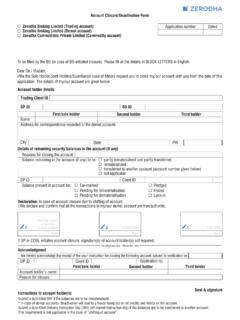Transcription of Risk Management & Trading Psychology
1 ZERODHA. Risk Management & Trading Psychology Table of Contents 1 Orientation note 1. 2 Risk (Part 1) 4. 3 Risk (Part 2) Variance & Covariance 10. 4 Risk (Part 3) Variance & Covariance Matrix 18. 5 Risk (Part 4) Correlation Matrix & Portfolio Variance 27. 6 Equity Curve 36. 7 Expected Returns 43. 8 Portfolio Optimization (Part 1) 50. 9 Portfolio Optimization (Part 2) 61. 10 Value at Risk 72. 11 Position Sizing for active trader 84. 12 Position Sizing for active traders (Part 2) 92. 13 Position Sizing for active traders (Part 3) 98. 14 Kelly's Criterion 105. 15 Trading Biases 114. 16 Trading Biases (Part 2) 121. CHAPTER 1. Orientation Note A unique opportunity I'm excited about this brand new module on Varsity, wherein we will be discussing two important and closely related market topics Risk Management and Trading Psychology '.
2 While risk Management may seem straightforward, Psychology ' may sound boring. Trust me;. both these topics can potentially open up new realms of Trading . Risk Management , for instance, is not what you are thinking it goes beyond the usual topics of position sizing, stop loss and leverage. While Trading Psychology is a reflection of your actions in the markets helps you introspect and find answers to why and how you made a profit or a loss in a particular trade or investment. Given the exhaustive nature of these topics, I tried looking for ideas on how best I can structure this module, and what chapters to include, and to my surprise, there are no contents related to these topics.
3 Of course, you can find tonnes of content online, but they are all fragmented and lack continuity. This gives us both the opportunity and the responsibility to develop some dependable content around these topics, centered on the 1 Indian context. We will have to work as a team here we will take up the responsibility to post the content and you will have to take up the responsibility to enrich it by posting queries and comments. What to expect? At this stage, I can give you a brief orientation on what to expect, however as we proceed, if necessary I'll take the liberty to alter the learning methodology, although not too drastically. So there are 2 main topics we are dealing with here.
4 1. Risk Management 2. Trading Psychology Risk Management techniques vary based on how you are positioned in the market. For example, if you have a single position in the market, then your approach to risk Management is very different compared to the risk Management techniques of multiple positions, which is again completely different compared to the risk Management techniques of a portfolio. Given this, we will look at risk Management from multiple angles . 1. Risk Management from a single Trading position 2. Risk Management from multiple Trading positions 3. Risk Management for a portfolio In my attempt to explain the above, I will cover the following topics . 1. Risk and its many forms 2.
5 Position sizing guess this one is mandatory to cover 3. Single position risk 4. Multiple position risk and hedging 5. Hedging with options 6. Portfolio attributes and risk estimation 7. Value at Risk 8. Asset allocation and its impact on risk (and returns). 9. Insights from the portfolio equity curve I'm guessing these topics will give you a completely different perspective on risk and how one can manage risk. Further, we would be discussing Trading Psychology both from a trader and an investor's perspective. The discussion would largely involve cognitive biases, mental models, common 2 pitfalls, and the thought process which leads you these pitfalls. Here are some of the topics we would be discussing in this section.
6 1. Anchoring bias 2. Regency bias 3. Confirmation bias 4. Bandwagon effect 5. Loss aversion 6. Illusion of control 7. Hindsight bias Of course, we will build upon this as we proceed. This is going to be an exciting discussing these topics. Stay tuned. 3 CHAPTER 2. Risk (Part 1). Warming up to risk For every rupee of profit made by a trader, there must be a trader losing that rupee. As an extension of this, if there is a group of traders consistently making money, then there must be another group of traders consistently losing money. Usually, this group making money consistently is small, as opposed to the group of traders who lose money consistently. The difference between these two groups is their understanding of Risk and their techniques of money Management .
7 Mark Douglas, in his book The Disciplined Trader', say s successful Trading is 80% money Management and 20% strategy. I could not agree more. Money Management and associated topics largely involve assessment of risk. So in this sense, understanding risk and its many forms become essential at this point. For this reason, let us break down risk to its elementary form to get a better understanding of risk. The usual layman definition of risk in the context of the stock market is the probability of losing money'. When you transact in the markets, you are exposed to risk, which means you can (possibly) lose money. For example, when you buy the stock of a company, whether you like it or not, you are exposed to risk.
8 Further, at a very high level, risk can be broken down into two types Systematic Risk and Unsystematic Risk. You are automatically exposed to both these categories of risks when you own a stock. Think about it, why do you stand to lose money? Or in other words, what can drag the stock price down? Many reasons as you can imagine, but let me list down a few . 1. Deteriorating business prospects 2. Declining business margins 3. Management misconduct 4. Competition eating margins All these represent a form of risk. In fact, there could be many other similar reasons and this list can go on. However, if you notice, there is one thing common to all these risks they are all risks specific to the company.
9 For example, imagine you have an investable capital of ,00,000/-. You decide to invest this money in HCL Technologies Limited. A few months 4 later HCL declares that their revenues have declined. Quite obviously HCL stock price will also decline. Which means you will lose money on your investment. However, this news will not impact HCL's competitor's stock price (Mindtree or Wipro). Likewise, if HCL's Management is guilty of any misconduct, then HCL's stock price will go down and not its competitors. Clearly, these risks are specific to this one company alone and not its peers. Let me elaborate on this I'm not sure how many of you were Trading the markets when the Satyam scam' broke out on the morning of 7th January 2009.
10 I certainly was, and I remember the day very well. Satyam Computers Limited had been cooking its books, inflating numbers, mishandling funds, and misleading its investors for many years. The numbers sho wn were way above the actual, myriads of internal party transactions; all these resulting in inflated stock prices. The bubble finally burst, when the then Chairman, Raju made a bold confession of this heinous financial crime via a letter addressed to the investors, stakeholders, clients, employees, and exchanges. You have to give him credit for taking such a huge step; I guess it takes a massive amount of courage to own up to such a crime, especially when you are fully aware of the ensuing consequences.













